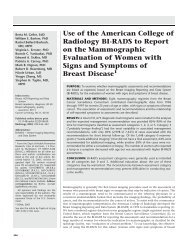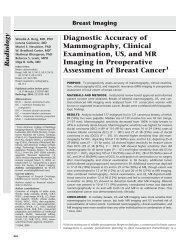Use of Microcalcification Descriptors in BI-RADS 4th ... - Quantason
Use of Microcalcification Descriptors in BI-RADS 4th ... - Quantason
Use of Microcalcification Descriptors in BI-RADS 4th ... - Quantason
You also want an ePaper? Increase the reach of your titles
YUMPU automatically turns print PDFs into web optimized ePapers that Google loves.
BREAST IMAGING: <strong>BI</strong>-<strong>RADS</strong> <strong>Microcalcification</strong> <strong>Descriptors</strong><br />
Burnside et al<br />
nancy relat<strong>in</strong>g to the fact that these<br />
microcalcifications arise <strong>in</strong> scattered<br />
glands, lobules, or the stromal elements<br />
<strong>of</strong> the breast and thus are more likely<br />
benign. These results are similar to<br />
those <strong>of</strong> previous work (9).<br />
<strong>Descriptors</strong> assess<strong>in</strong>g the stability <strong>of</strong><br />
microcalcifications were also highly predictive<br />
<strong>of</strong> malignancy <strong>in</strong> our study; a<br />
large proportion <strong>of</strong> malignant cases exhibited<br />
<strong>in</strong>creas<strong>in</strong>g microcalcifications.<br />
Aga<strong>in</strong>, our results support a forego<strong>in</strong>g<br />
<strong>in</strong>vestigation (13) that analyzes the predictive<br />
value <strong>of</strong> stability for microcalcifications.<br />
Stability descriptors are not <strong>in</strong>cluded<br />
<strong>in</strong> the <strong>BI</strong>-<strong>RADS</strong> lexicon but are<br />
widely accepted to aid differentiation <strong>of</strong><br />
benign and malignant disease. Of note<br />
<strong>in</strong> our study, all stable microcalcifications<br />
were benign. However, this f<strong>in</strong>d<strong>in</strong>g<br />
must be viewed with caution because<br />
<strong>of</strong> our limited sample size. Results<br />
<strong>of</strong> previous research (13) document<br />
that stability <strong>of</strong> microcalcifications is not<br />
reliable for the exclusion <strong>of</strong> malignancy.<br />
In our study, we analyzed the predictive<br />
abilities <strong>of</strong> <strong>BI</strong>-<strong>RADS</strong> microcalcification<br />
descriptor classes (ie, morphologic,<br />
distribution, and stability) <strong>in</strong> isolation.<br />
In contrast to our study design,<br />
comb<strong>in</strong>ations <strong>of</strong> <strong>BI</strong>-<strong>RADS</strong> descriptors<br />
are rout<strong>in</strong>ely used <strong>in</strong> cl<strong>in</strong>ical practice to<br />
characterize mammographic abnormalities.<br />
In fact, the majority <strong>of</strong> abnormalities<br />
<strong>in</strong> our study were described with<br />
more than one descriptor. Although decid<strong>in</strong>g<br />
management on the basis <strong>of</strong> the<br />
most suspicious descriptor is accepted<br />
practice, the use <strong>of</strong> comb<strong>in</strong>ed descriptors<br />
may have a more powerful predictive<br />
ability than that <strong>of</strong> isolated descriptors.<br />
The <strong>BI</strong>-<strong>RADS</strong> <strong>4th</strong> edition gives ra-<br />
Table 3<br />
Rate <strong>of</strong> Malignancy <strong>of</strong> <strong>Microcalcification</strong>s as Function <strong>of</strong> Distribution and Morphologic <strong>Descriptors</strong><br />
Distribution<br />
Descriptor<br />
L<strong>in</strong>ear<br />
F<strong>in</strong>e<br />
Pleomorphic<br />
Morphologic Descriptor<br />
Coarse<br />
Amorphous<br />
Heterogeneous<br />
Typically<br />
Benign<br />
Total<br />
L<strong>in</strong>ear ductal 6/7 (86) 2/3 (67) 0/1 (0) NA 0/1 (0) 8/12 (67)<br />
Segmental NA 2/3 (67) 1/5 (20) NA NA 3/8 (38)<br />
Clustered 4/11 (36) 6/27 (22) 3/24 (13) 1/14 (7) 0/14 (0) 14/90 (16)<br />
Regional NA 0/1 (0) NA NA 0/3 (0) 0/4 (0)<br />
Scattered 0/1 (0) NA NA NA NA 0/1 (0)<br />
Total 10/19 (53) 10/34 (29) 4/30 (13) 1/14 (7) 0/18 (0) 25/115 (21.7)<br />
Note.—Numbers are raw data, with percentages <strong>in</strong> parentheses. NA not applicable.<br />
Figures 4, 5<br />
Figure 4: Graph demonstrates probability <strong>of</strong> malignancy <strong>of</strong> abnormalities accord<strong>in</strong>g<br />
to comb<strong>in</strong>ed morphologic and distribution descriptors. Pleo pleomorphic,<br />
Heter heterogeneous.<br />
Figure 5: Graph demonstrates probability <strong>of</strong> malignancy <strong>of</strong> abnormalities<br />
accord<strong>in</strong>g to comb<strong>in</strong>ed morphologic and stability descriptors. Pleo pleomorphic,<br />
Heter heterogeneous.<br />
Radiology: Volume 242: Number 2—February 2007 393





